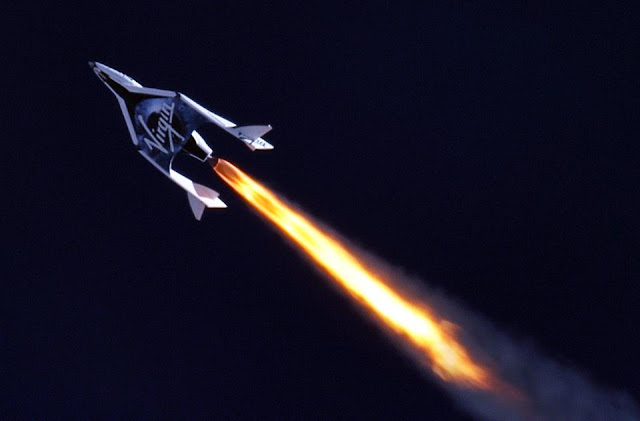Virgin Galactic logo.
April 29, 2013
Sir Richard Branson witnesses vehicle-proving milestone as company sets year-end goal for spaceflight
First Rocket-Powered Flight of SPACESHIPTWO
Today, Virgin Galactic, the world’s first commercial spaceline owned by Sir Richard Branson’s Virgin Group and Abu Dhabi’s aabar Investments PJS, completed the first rocket-powered flight of its space vehicle, SpaceShipTwo (SS2). The test, conducted by teams from Scaled Composites (Scaled) and Virgin Galactic, officially marks Virgin Galactic’s entrance into the final phase of vehicle testing prior to commercial service from Spaceport America in New Mexico.
Spaceport America in New Mexico
“The first powered flight of Virgin Spaceship Enterprise was without any doubt, our single most important flight test to date,” said Virgin Galactic Founder Sir Richard Branson, who was on the ground in Mojave to witness the occasion. “For the first time, we were able to prove the key components of the system, fully integrated and in flight. Today’s supersonic success opens the way for a rapid expansion of the spaceship’s powered flight envelope, with a very realistic goal of full space flight by the year’s end. We saw history in the making today and I couldn’t be more proud of everyone involved.”
The test began at 7.02am local time when SS2 took off from Mojave Air and Space Port mated to WhiteKnightTwo (WK2), Virgin Galactic’s carrier aircraft. Piloting SS2 were Mark Stucky, pilot, and Mike Alsbury, co-pilot, who are test pilots for Scaled, which built SS2 for Virgin Galactic. At the WK2 controls were Virgin Galactic’s Chief Pilot Dave Mackay, assisted by Clint Nichols and Brian Maisler, co-pilot and flight test engineer, respectively, for Scaled.
First Rocket-Powered Flight of SPACESHIPTWO
Upon reaching 47,000 feet altitude and approximately 45 minutes into the flight, SS2 was released from WK2. After cross-checking data and verifying stable control, the pilots triggered ignition of the rocket motor, causing the main oxidizer valve to open and igniters to fire within the fuel case. At this point, SS2 was propelled forward and upward to a maximum altitude of 55,000 feet. The entire engine burn lasted 16 seconds, as planned. During this time, SS2 went supersonic, achieving Mach 1.2.
“We partnered with Virgin Galactic several years ago with the aspiration to transform and commercialize access to space for the broader public,” said His Excellency Khadem Al Qubaisi, Chairman of aabar Investments PJS. “Today’s test is another key milestone in realizing that aspiration. Our partnership goes from strength to strength, and is an excellent example of aabar’s desire to participate in the development of world class technologies that are commercially viable and strategically important, both for the company, its shareholders, and for Abu Dhabi.”
The entire rocket-powered flight test lasted just over 10 minutes, culminating in a smooth landing for SS2 in Mojave at approximately 8am local time.
“The rocket motor ignition went as planned, with the expected burn duration, good engine performance and solid vehicle handling qualities throughout,” said Virgin Galactic President & CEO George Whitesides. “The successful outcome of this test marks a pivotal point for our program. We will now embark on a handful of similar powered flight tests, and then make our first test flight to space.”
Virgin Galactic SpaceShip flight description (click on the image for enlarge)
In the coming months, the Virgin Galactic and Scaled test team will expand the spaceship’s powered flight envelope culminating in full space flight, which the companies anticipate will take place before the end of 2013.
“I’d like to congratulate the entire team,” said President of Scaled Kevin Mickey. “This milestone has been a long time coming and it’s only through the hard work of the team and the tremendous support of Virgin Galactic that we have been able to witness this important milestone. We look forward to all our upcoming tests and successes.”
About Virgin Galactic:
Virgin Galactic, owned by Sir Richard Branson’s Virgin Group and aabar Investments PJS , is on track to be the world’s first commercial spaceline. To date, the company has accepted more than $70 million in deposits from approximately 580 individuals, which is approximately 10% more than the total number of people who have ever gone to space. The new spaceship (SpaceShipTwo, VSS Enterprise) and carrier craft (WhiteKnightTwo, VMS Eve) have both been developed for Virgin Galactic’s vehicle fleet by Mojave-based Scaled Composites . Founded by Burt Rutan, Scaled developed SpaceShipOne, which in 2004 claimed the $10 million Ansari X Prize as the world’s first privately developed manned spacecraft. Virgin Galactic’s new vehicles, which will be manufactured by Virgin Galactic in Mojave, Calif., share much of the same basic design, but are being built to carry six customers, or the equivalent scientific research payload, on suborbital space flights. The vehicles will allow an out-of-the-seat, zero-gravity experience with astounding views of the planet from the black sky of space for tourist astronauts and a unique microgravity platform for researchers. The VSS Enterprise and VMS Eve test flight program is well under way, leading to Virgin Galactic commercial operations, which will be based at Spaceport America in New Mexico.
About aabar Investments PJS:
Headquartered in Abu Dhabi, aabar Investments PJS invests in various sectors including infrastructure, aviation, real estate, automotive, commodities, energy and financial services. IPIC acquired a stake in aabar in 2008 and has since progressively increased its stake to the current level of 95%. Since IPIC’s initial investment, aabar has made numerous investments including stakes in Daimler AG, Falcon Private Bank Ltd., Mercedes-Benz Grand Prix Limited, UniCredit S.p.A., Galactic Ventures LLC, XOJET, Inc., Glencore International plc and a portfolio of real estate projects.
For more information about Virgin Galactic, visit: http://www.virgingalactic.com/
Images, Video, Text, Credits: Virgin Galactic / MarsScientific.com and Clay Center Observatory.
Cheers, Orbiter.ch




